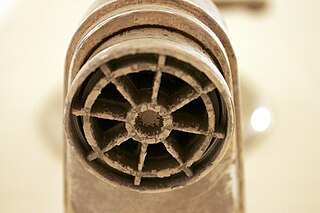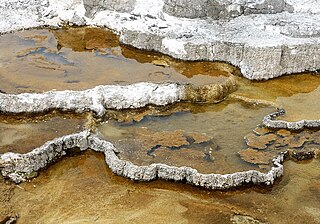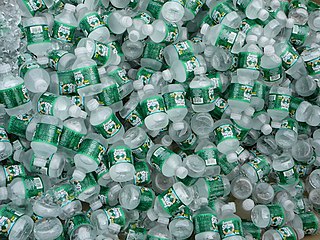
A soft drink is any water-based flavored drink, usually but not necessarily carbonated, and typically including added sweetener. Flavors used can be natural or artificial. The sweetener may be a sugar, high-fructose corn syrup, fruit juice, a sugar substitute, or some combination of these. Soft drinks may also contain caffeine, colorings, preservatives and other ingredients.

Distilled water is water that has been boiled into vapor and condensed back into liquid in a separate container. Impurities in the original water that do not boil below or near the boiling point of water remain in the original container. Thus, distilled water is a type of purified water.
Water purification is the process of removing undesirable chemicals, biological contaminants, suspended solids, and gases from water. The goal is to produce water that is fit for specific purposes. Most water is purified and disinfected for human consumption, but water purification may also be carried out for a variety of other purposes, including medical, pharmacological, chemical, and industrial applications. The history of water purification includes a wide variety of methods. The methods used include physical processes such as filtration, sedimentation, and distillation; biological processes such as slow sand filters or biologically active carbon; chemical processes such as flocculation and chlorination; and the use of electromagnetic radiation such as ultraviolet light.

Carbonated water is water containing dissolved carbon dioxide gas, either artificially injected under pressure or occurring due to natural geological processes. Carbonation causes small bubbles to form, giving the water an effervescent quality. Common forms include sparkling natural mineral water, club soda, and commercially produced sparkling water.

A spring is a natural exit point at which groundwater emerges out of the aquifer and flows onto the top of the Earth's crust (pedosphere) to become surface water. It is a component of the hydrosphere, as well as a part of the water cycle. Springs have long been important for humans as a source of fresh water, especially in arid regions which have relatively little annual rainfall.

Calcium chloride is an inorganic compound, a salt with the chemical formula CaCl2. It is a white crystalline solid at room temperature, and it is highly soluble in water. It can be created by neutralising hydrochloric acid with calcium hydroxide.

Bottled water is drinking water packaged in plastic or glass water bottles. Bottled water may be carbonated or not, with packaging sizes ranging from small single serving bottles to large carboys for water coolers. The consumption of bottled water is influenced by factors such as convenience, taste, perceived safety, and concerns over the quality of municipal tap water. Concerns about the environmental impact of bottled water, including the production and disposal of plastic bottles, have led to calls for more sustainable practices in the industry.

Hard water is water that has a high mineral content. Hard water is formed when water percolates through deposits of limestone, chalk or gypsum, which are largely made up of calcium and magnesium carbonates, bicarbonates and sulfates.

Mineral springs are naturally occurring springs that produce hard water, water that contains dissolved minerals. Salts, sulfur compounds, and gases are among the substances that can be dissolved in the spring water during its passage underground. In this they are unlike sweet springs, which produce soft water with no noticeable dissolved gasses. The dissolved minerals may alter the water's taste. Mineral water obtained from mineral springs, and the precipitated salts such as Epsom salt have long been important commercial products.

Purified water is water that has been mechanically filtered or processed to remove impurities and make it suitable for use. Distilled water was, formerly, the most common form of purified water, but, in recent years, water is more frequently purified by other processes including capacitive deionization, reverse osmosis, carbon filtering, microfiltration, ultrafiltration, ultraviolet oxidation, or electrodeionization. Combinations of a number of these processes have come into use to produce ultrapure water of such high purity that its trace contaminants are measured in parts per billion (ppb) or parts per trillion (ppt).

Water softening is the removal of calcium, magnesium, and certain other metal cations in hard water. The resulting soft water requires less soap for the same cleaning effort, as soap is not wasted bonding with calcium ions. Soft water also extends the lifetime of plumbing by reducing or eliminating scale build-up in pipes and fittings. Water softening is usually achieved using lime softening or ion-exchange resins, but is increasingly being accomplished using nanofiltration or reverse osmosis membranes.

Băile Tușnad is a town in Harghita County, Romania in eastern Transylvania.

Sulfur water is a condition where water is exposed to hydrogen sulfide gas, giving a distinct "rotten egg" smell. This condition has different purposes in culture varying to health and implications to plumbing.

Total dissolved solids (TDS) is a measure of the dissolved combined content of all inorganic and organic substances present in a liquid in molecular, ionized, or micro-granular suspended form. TDS are often measured in parts per million (ppm). TDS in water can be measured using a digital meter.

Selters is a German brand of natural mineral water sourced from wells in the area of Selters in Hesse, at the Taunus mountains. The water has been known since the Bronze Age and famous as a natural soda water because of its high concentration of sodium bicarbonate, "soda". The Selters water also contains raised levels of calcium, chloride, magnesium, sulfate and potassium ions. The water is naturally carbonated, over 250 mg/L, but sold in both sparkling and still versions.

Pitkeathly Wells is a hamlet in the Perth and Kinross area of Scotland, famed for its mineral water. The water was recommended for health during the 19th century, and was bottled for sale, sometimes carbonated. In 1910, Schweppes took over bottling the water, however, they shut down production after a fire.
Jamnica plus LLC is a Croatian limited liability company which produces carbonated mineral water, as well as other bottled waters and soft drinks. It was founded on 18 October 1828, and operates as a part of the Beverages Group, an organizational division within the Fortenova Group.
Donat is a natural mineral water from the springs of Rogaška Slatina in Slovenia. It has a high content of magnesium. It helps with constipation problems, heartburn and magnesium deficiency problems.

The United States is the largest consumer market for bottled water in the world, followed by Mexico, China, and Brazil.
















